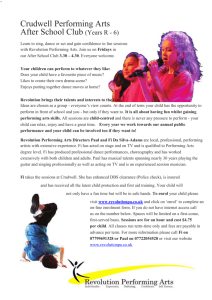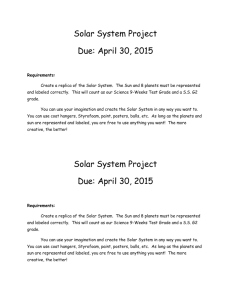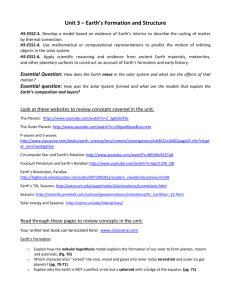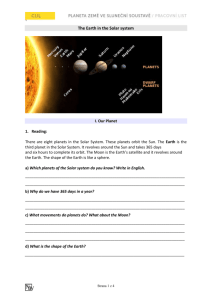The Starry Night Time and Day Time
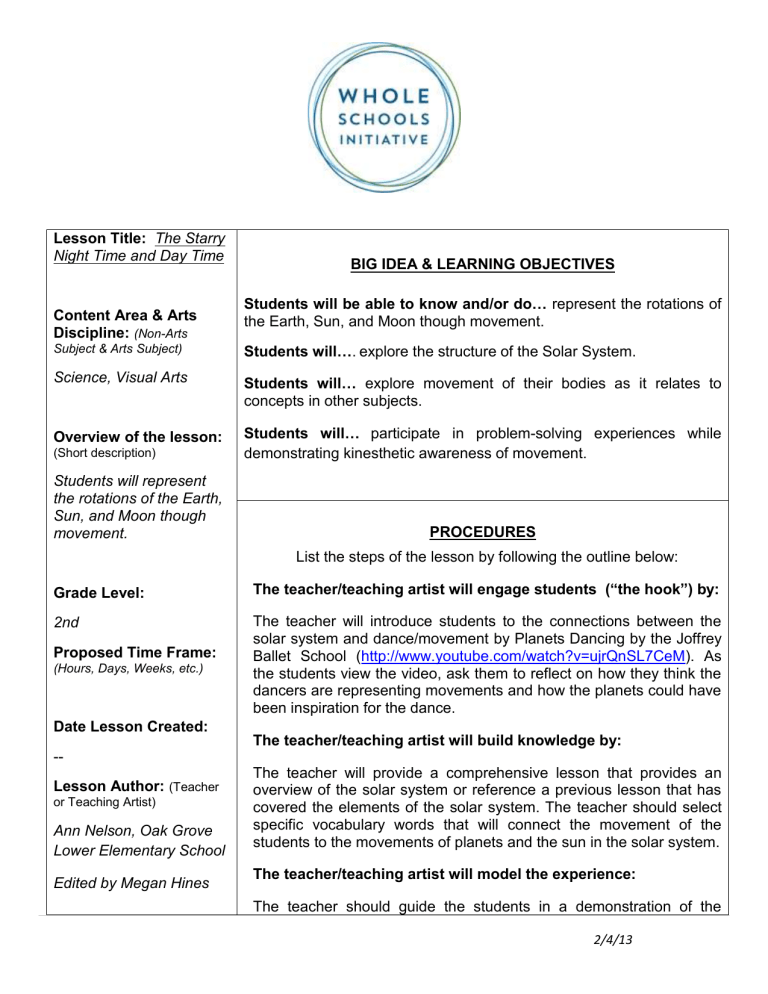
Lesson Title: The Starry
Night Time and Day Time
Content Area & Arts
Discipline: (Non-Arts
Subject & Arts Subject)
Science, Visual Arts
BIG IDEA & LEARNING OBJECTIVES
Students will be able to know and/or do…
represent the rotations of the Earth, Sun, and Moon though movement.
Students will… .
explore the structure of the Solar System.
Students will… explore movement of their bodies as it relates to concepts in other subjects.
Students will… participate in problem-solving experiences while demonstrating kinesthetic awareness of movement.
Overview of the lesson:
(Short description)
Students will represent the rotations of the Earth,
Sun, and Moon though movement. PROCEDURES
List the steps of the lesson by following the outline below:
The teache r/teaching artist will engage students (“the hook”) by:
Grade Level:
2nd
Proposed Time Frame:
(Hours, Days, Weeks, etc.)
The teacher will introduce students to the connections between the solar system and dance/movement by Planets Dancing by the Joffrey
Ballet School ( http://www.youtube.com/watch?v=ujrQnSL7CeM ). As the students view the video, ask them to reflect on how they think the dancers are representing movements and how the planets could have been inspiration for the dance.
Date Lesson Created:
--
The teacher/teaching artist will build knowledge by:
Lesson Author: or Teaching Artist)
(Teacher
Ann Nelson, Oak Grove
Lower Elementary School
The teacher will provide a comprehensive lesson that provides an overview of the solar system or reference a previous lesson that has covered the elements of the solar system. The teacher should select specific vocabulary words that will connect the movement of the students to the movements of planets and the sun in the solar system.
Edited by Megan Hines
The teacher/teaching artist will model the experience:
The teacher should guide the students in a demonstration of the
2/4/13
Room Requirements &
Arrangement: (Location of chairs, classroom or gym, etc.)
Classroom, outdoor space or gym where students can move
Materials/Equipment:
(Arts supplies, tech equipment, etc.)
One yellow punch ball
Eight balloons of different colors
Chalk
Globe
Resources: (Additional books, website addresses, images, etc.)
YouTube - "Planets
Dancing" by the Joffrey
Ballet School http://goo.gl/ABJfXi
Vocabulary: (Key words for both the non-arts and arts subjects)
Rotation
Revolution
Space
Earth
Sun
Solar System
Movement dance vocabulary that the students will be using to create their dances.
The teacher/teaching artist will guide the practice with the students by:
Role-playing to demonstrate the universe and its connection to the sun. Using one yellow punch ball, eight balloons of different colors, and chalk students role-play to demonstrate the universe and its connection to the sun. This activity will explore the concepts of
"revolution" and "rotation". Have eight paths marked on the ground or floor with chalk. Have one student hold each balloon. Another student will hold the yellow punch ball that represents the sun. The "sun" stands in the middle of the circle. The other children take their places on the marked paths. The teacher will need to give each child the name of his/her planet and direct him/her to the correct place.
Begin the experiment by having children walk in their path or "orbit" around the sun. Stress that the planets never leave their own orbits.
This travel around the sun is called "revolution". This term should now be introduced. After the children have orbited the sun once; bring in the added concept of "rotation". While moving around the sun, the children should also start to spin around like tops. This demonstrates
"rotation". Tell children that it takes one year for the earth to revolve around the sun, and it takes one day for the earth to rotate on its own axis. Point out that "rotation" or spinning on one's own axis takes much less time than going all the way around the sun, "revolution."
Give all children in the class a chance to participate in the role-playing activity.
The students will apply understanding by:
After returning to the classroom, demonstrate the principle just learned with the globe. Let some spin the globe and walk around a
"sun" to show "rotation" and "revolution". Have students apply their understanding by then reacting how the vocabulary words can be applied through movement in space and on the globe. This same type of activity can be used to show the relationship between the moon and the earth.
The teacher/teaching artist will create opportunities for reflection
(Closing) by:
Ask students to reflect how they using their bodies related to their understanding solar system and how the planets interact with one another.
The teacher/teaching artist will assess the students’ learning by:
The teacher will assess through observation and student participation.
2/4/13
STANDARDS & PRINCIPLES
Please list the competency from the following:
State Content Standards (i.e. CCSS , Mississippi Frameworks ):
Science
4. Develop an understanding of the properties of Earth materials, objects in the sky, and changes in Earth and sky. e. Model and explain the concept of Earth’s rotation as it relates to day and night and infer why it is usually cooler at night than in the day. f. Describe characteristics and effects of objects in the universe.
-Position of the sun in relation to a fixed object on Earth at various times (day and night)
Arts Standards (i.e. MS Visual & Performing Arts Frameworks ):
Dance
1. Acquire a basic understanding of movement skills with increasing proficiency. (CP, C) b. Demonstrate the ability to vary control and direct forces of human energy used in basic axial and motor skills. c. Properly demonstrate and create locomotor movements with various accompaniments while employing spatial concepts of direction and pathways (e.g., sideways, curved, zigzagged).
2. Exhibit movement problem-solving experiences while demonstrating kinesthetic awareness of movement. (CP, CA) c. Explore basic actions of the body while traveling (alone and with partners) through space in a given spatial pattern or design (e.g., circle, line, square).
3. Develop a greater understanding of the elements of dance. (CP, CA) c. Create visual art to represent time, space, or energy in movement.
6. Perceive the meaning and beauty of dance. (CA, A) a. Identify and name dance movement using correct dance terminology.
Principles of Universal Design for Learning (at least one from each of the three guiding principles):
Provide Multiple Means of Representation
1.2 Offer alternatives for auditory information
1.3 Offer alternatives for visual information
2.3 Support decoding of text, mathematical notation, and symbols
3.4 Maximize transfer and generalization
Provide Multiple Means of Action and Expression
6.3 Facilitate managing information and resources
2/4/13
6.4 Enhance capacity for monitoring progress
Provide Multiple Means of Engagement
8.2 Vary demands and resources to optimize challenge
8.3 Foster collaboration and community
APPENDIX
Extended Learning Activities:
Students could develop their own more complex dancing to show how the Earth and moon interact with one another.
The teacher could extend the lesson to visual arts by showing prints such as Vincent van Gogh’s Starry Night.
TIPS/FAQs:
--
References: (i.e. Works cited, etc.)
--
2/4/13
